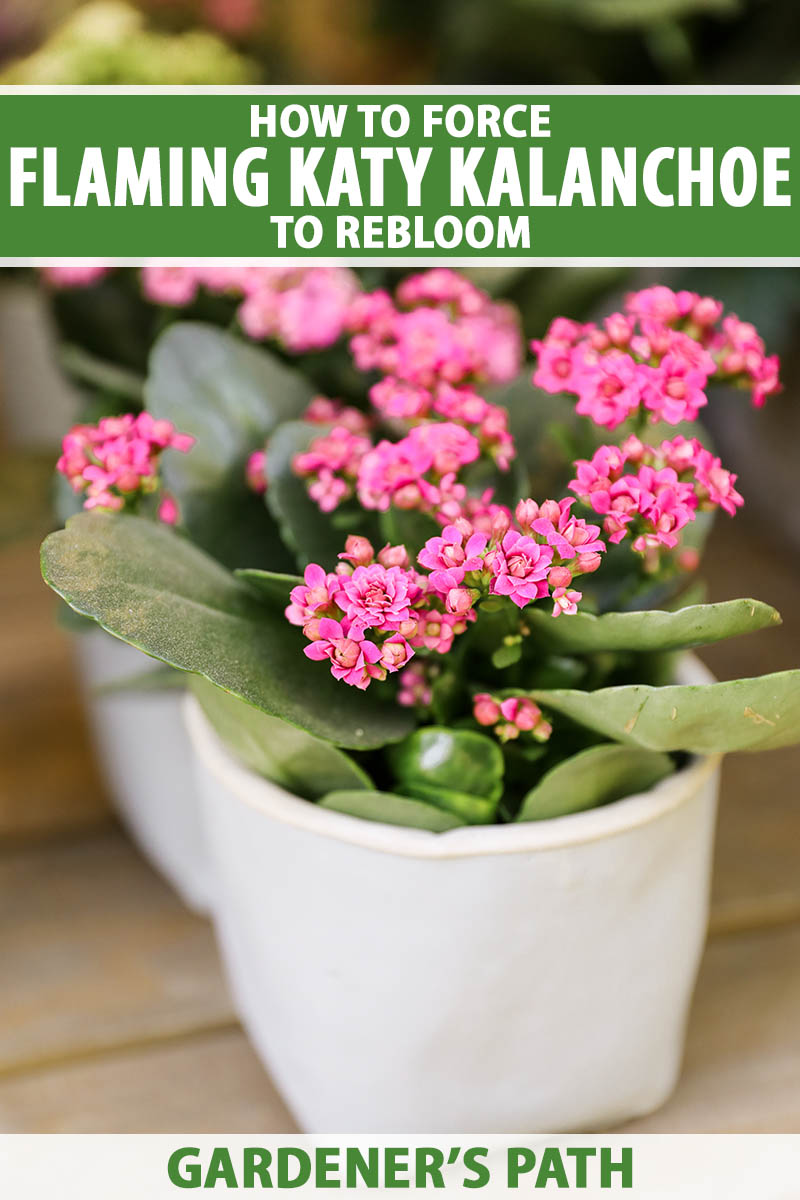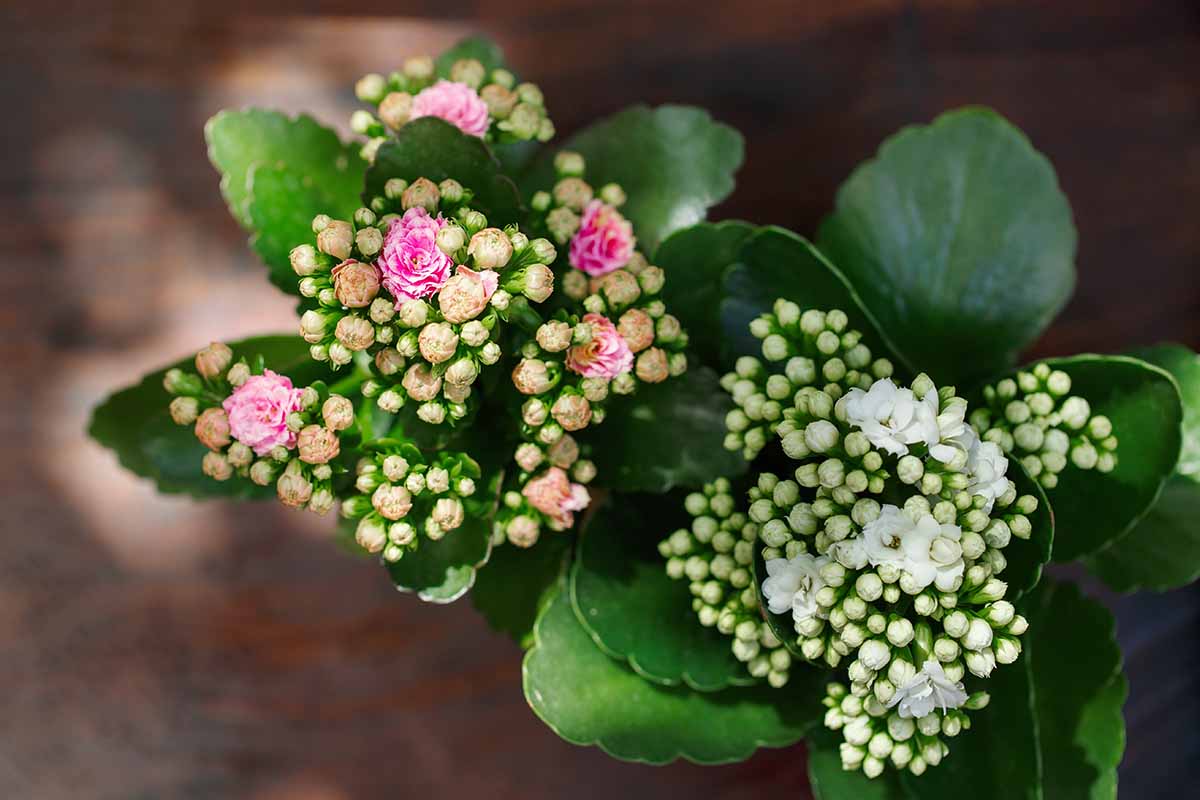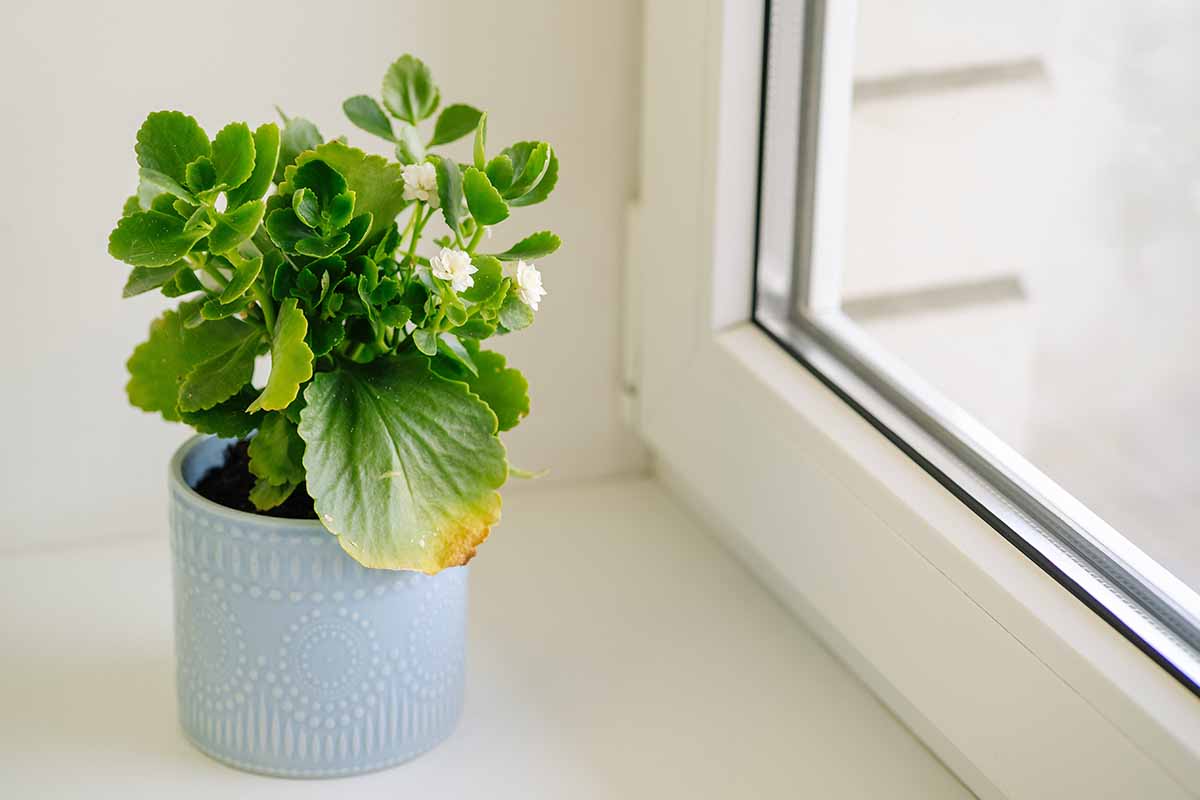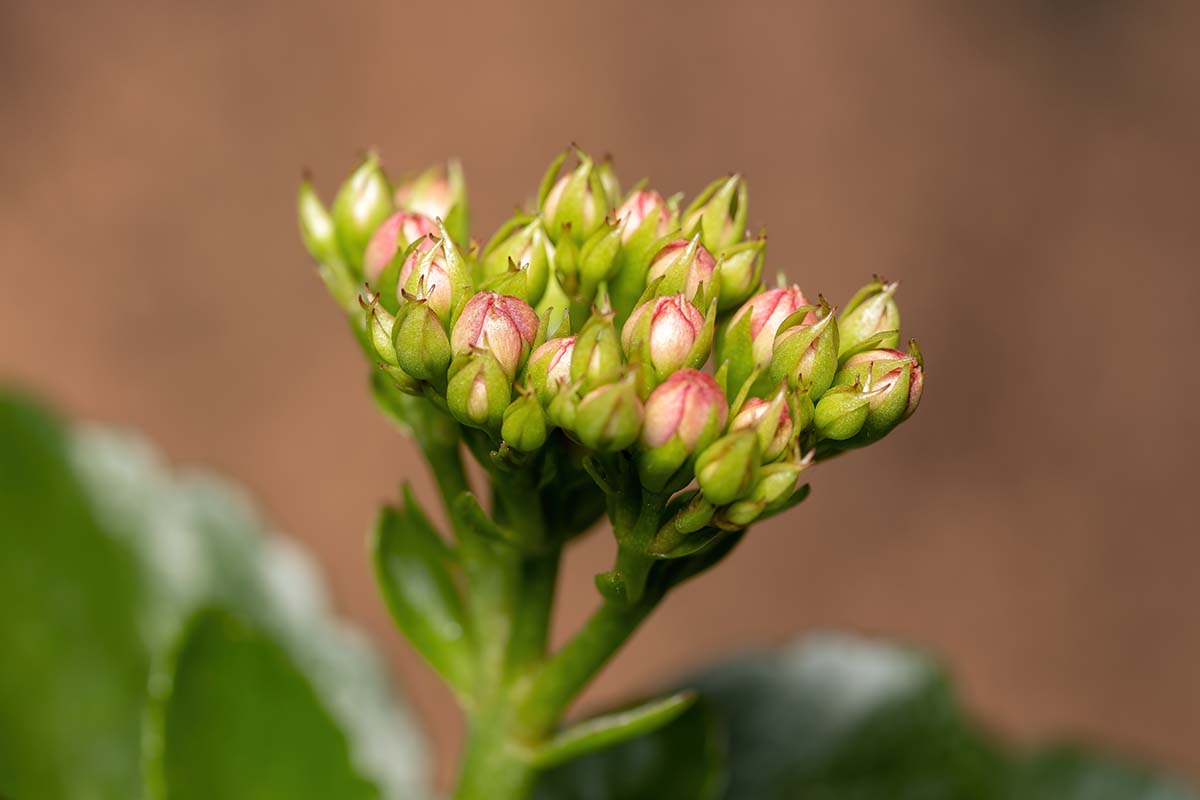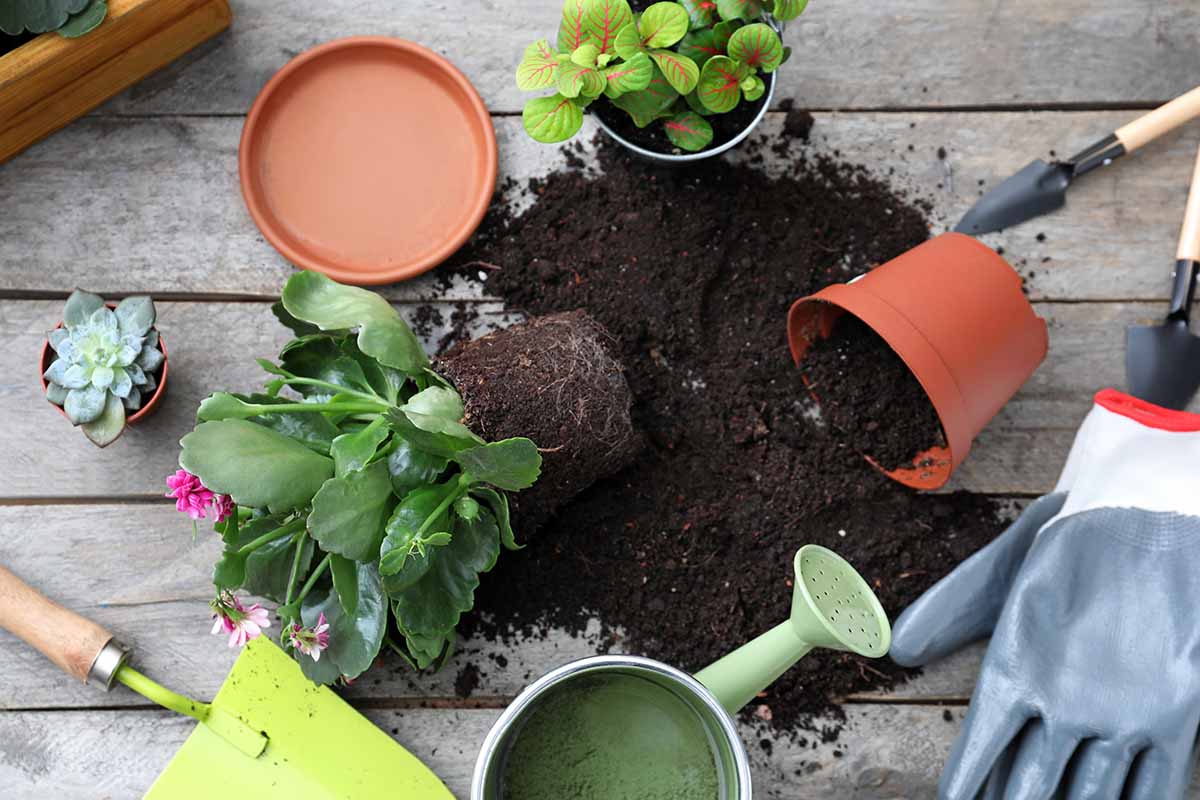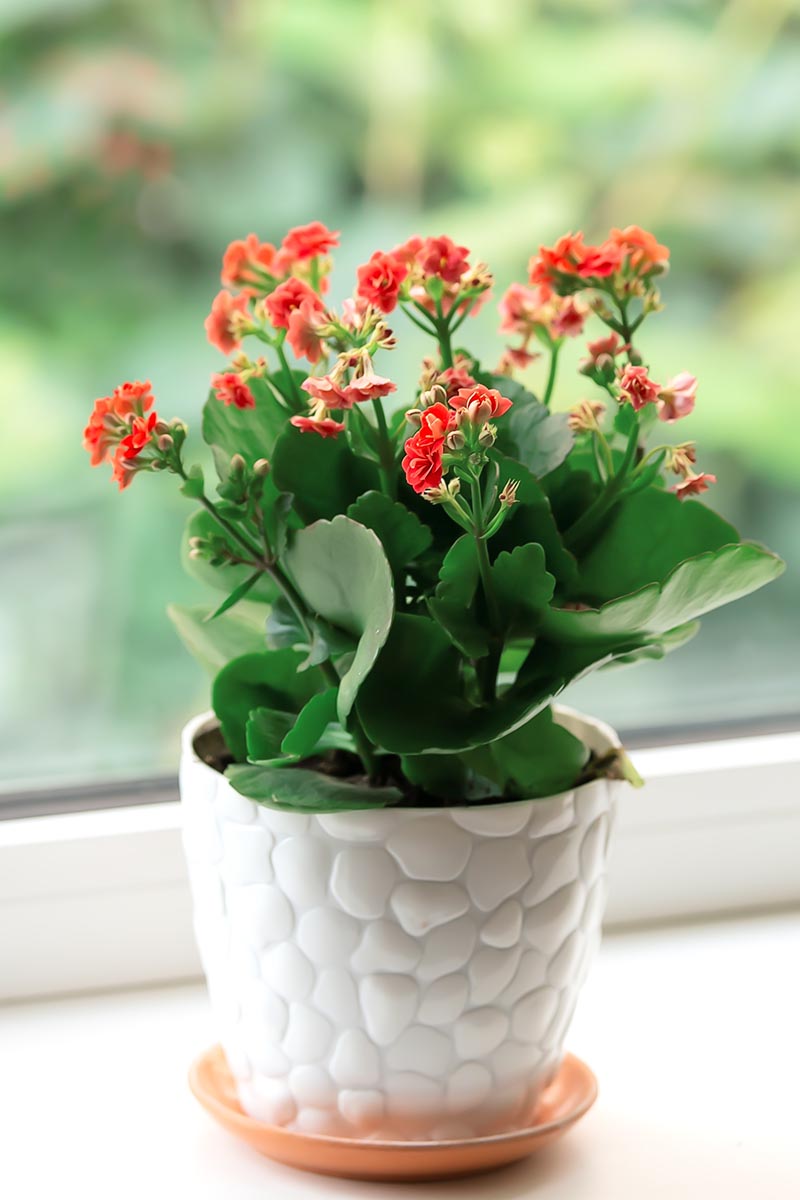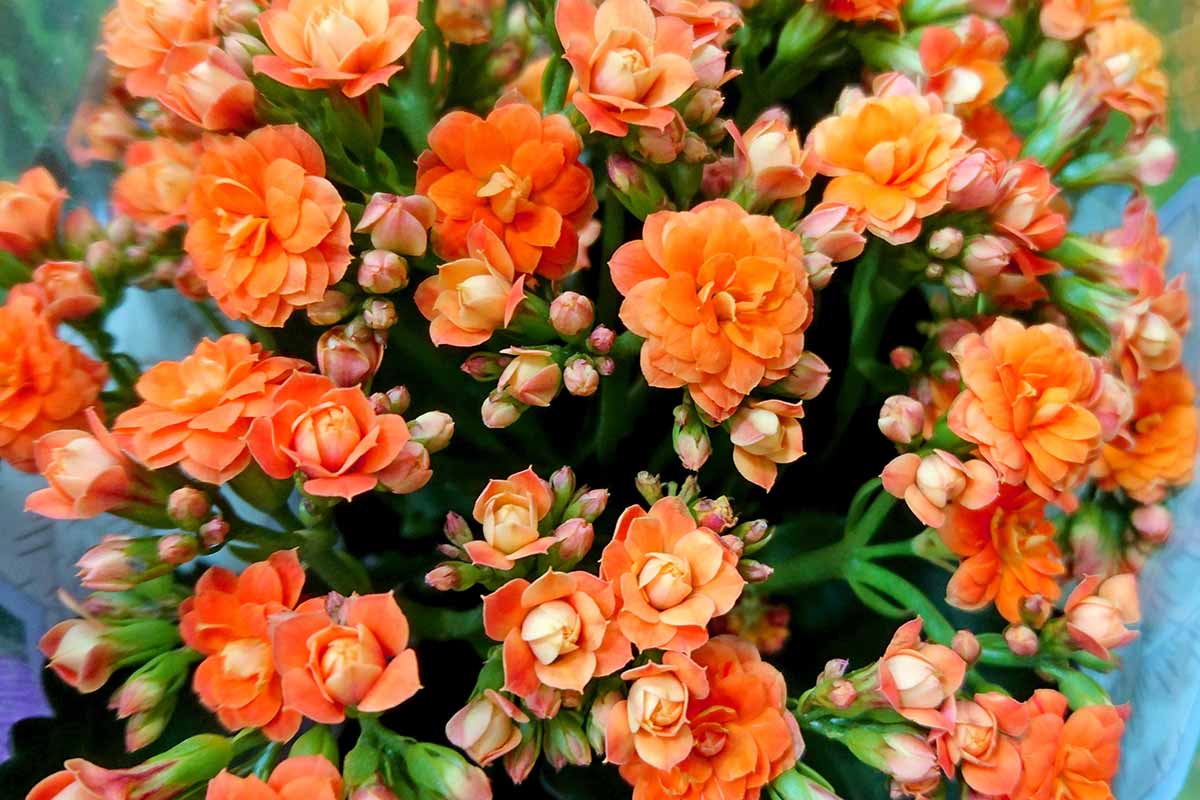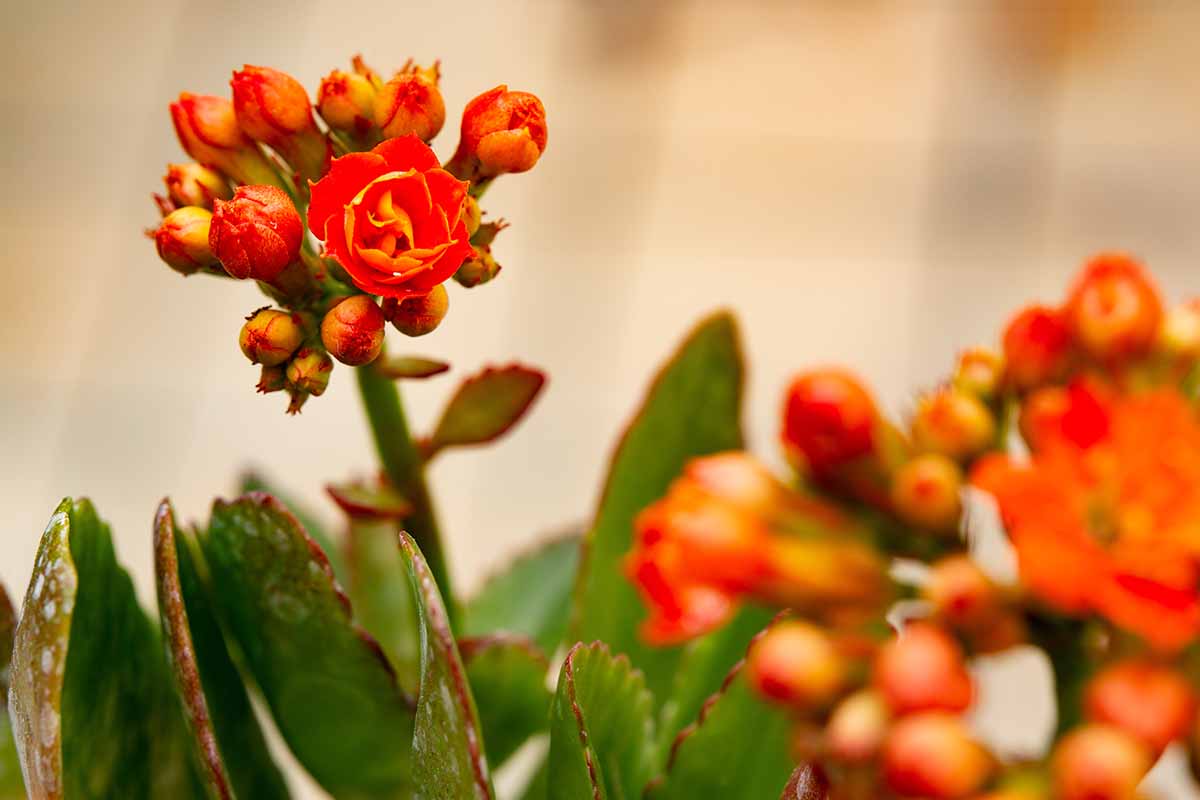You must admit it’s impossible to truly force a member of the plant kingdom to do anything. When I hear someone say “force,” I envision a cartoon villain looming over the plant to threaten, “We have ways to make you flower…” But while you can’t technically “force” K. blossfeldiana to form new buds or bloom, you can strongly encourage that outcome. You’ll likely see results if you’re conscientious and patient with the process. I’ll share the “forcing” basics here, and I’ll only address this one species of kalanchoe as a candidate for forced reblooming. We link to vendors to help you find relevant products. If you buy from one of our links, we may earn a commission. It produces clusters of flowers held above shiny green leaves with serrated edges. The blooms can be white, red, salmon, yellow, pink, or orange. Most varieties have four-petaled flowers, but some from the Calandiva® series produce rosettes with 26 petals. While other species from the Kalanchoe genus do flower, they typically only do so outdoors in their native regions in the wild, or in climates where they’re hardy. Mother of millions plants grown outdoors year-round send up stalks of coral-colored, bell-shaped blooms in late winter to early summer, for example. But these are monocarpic plants that bloom just once in their lives. They so rarely bloom indoors that it wouldn’t be worth the hassle of trying to force them to flower. But florist’s kalanchoe does so much more readily and more than once, for a show of flowers to brighten your decor over and over again in the right conditions. If you’d like to promote repeated blooming indoors, flaming Katy is the go-to kalanchoe. I’ll be sharing the how-tos. Here’s everything we’ll cover in this guide:
The Outdoor Experience
In mild climates without frozen winters, specifically in USDA Hardiness Zones 10 to 12, gardeners can grow flaming Katy outdoors year-round. In these areas, if the light conditions are favorable, the plant will rebloom on its own. But it will need about six weeks of low natural light, with no more than 10 hours of sunlight a day throughout that period, to prepare for blooming. In most areas, the onset of late fall and winter brings those short days and long nights with it. In a few parts of Zones 10 to 12, like Hawaii, the day length doesn’t diminish enough between October to March to provide this plant with the 14 hours of darkness it needs to form buds. Even though it may be warm enough to grow florist’s kalanchoe as a perennial in a garden plot or border in those places, the plant won’t bloom outdoors in areas that don’t have those shorter days. If you’re sold on the idea of blooms and live in one of those spots, it’s a good idea to plant your flaming Katy in containers so you can bring it indoors to force blooming with artificial short-day conditions. Gardeners who aren’t in Zones 10 to 12 need to overwinter flaming Katy indoors or grow it as a houseplant. To trigger the plants to bloom again, you’ll need to manipulate the light indoors to mimic winter days, even when your plants are placed outdoors in containers for most of the spring and summer. Details on that are coming right up.
Timing Is Everything
While you can propagate kalanchoe at any time of year, encouraging flaming Katy to rebloom indoors is best done starting in the early fall, after the initial flush of flowers is spent and when the days are already beginning to shorten. As mentioned, to encourage flower buds to develop, the plants need at least six weeks of limited light. Provide 14 to 16 hours of darkness each day until you see blooms beginning to form. If you time this effort to coincide with the days that include 10 or fewer hours of light naturally, starting in October, you won’t have to work as hard to create artificial darkness indoors. In areas with short winter days, you may be able to leave the plants in a room with natural lighting instead of moving them in and out of closets daily. This only works if you also turn off any supplemental lighting before or at the same time that it gets dark outside, though. Beginning the bloom forcing process in fall also allows you to enjoy the flowers to come during the darkest days of winter. The whole cycle takes about 12 weeks, six weeks for the buds to appear, and another six for them to burst into bloom. So get out your calendar or mark the date in your gardening journal. Starting this process in early October should yield flowers in early January. Of course, you can start at any time that provides a long enough period to rely on the naturally shorter days in your location, as long as you have completed the six weeks of dark conditions for 14 to 16 hours per day before the days naturally get longer. And if you’re willing to spend the time and energy limiting the light and you give the plants a few months to rest between bouts of forced blooming, you may have enough time to work this magic twice in one year.
How to Force Kalanchoe to Rebloom Indoors
When you treat yourself to a flaming Katy that’s already flowering in a riot of color in early winter, or if you receive one as a gift that’s already in bloom at this time of year, you can sit back and enjoy the display. The plants might flower for up to two months, or just a short while, depending how long they were blooming before they came into your possession. All told, they’ll flower for around eight weeks after the first blooms appear. Kalanchoe in bloom will thrive in temperatures between 45 and 65°F at night, and 50 to 70°F during the day. The plants will grow just fine in low to bright light during that initial bloom period, and just need to be watered when the soil is dry to the touch. Keeping the spent blooms deadheaded will promote more buds, too. Read more about caring for and maintaining these plants in our growing guide. But what if your indoor flaming Katy has already finished blooming? After that appealing display has come to a close, you can opt to compost the plant, or to continue to enjoy the foliage as an easy-care succulent houseplant. You’ll need to take a few extra steps if you’d like this succulent to rebloom the following winter, though. First, after the blooms are finished and you’ve trimmed them away, give the plant a light pruning as needed, cutting the tips of any leggy branches down to the first leaf node. Next, moving your florist’s kalanchoe to a container one size larger is recommended at this time. It’s best to use a specialty potting soil mix formulated for succulents and cacti that drains quickly, and be sure to pick a pot with a drainage hole at the bottom. You can learn more about choosing the best growing medium and containers for you houseplants in our guide. Until it’s warm enough for your flaming Katy to move back outside in spring, it’s important to make sure the plant receives at least six hours a day of bright light indoors. A bright, south-facing window may be enough to meet their needs, or you can use supplemental grow lights. After all danger of frost has passed in the spring, you can move the pots to a protected spot outdoors if you like. Or, they can continue living their best life inside. Outside, the plants will still need plenty of light, about five hours of full sun or bright light per day at a minimum. But outdoor plants also require protection from harsh afternoon sun. Make sure you reintroduce your florist’s kalanchoe to outdoor growing conditions gradually, starting with a few hours outdoors the first morning, and adding a couple more hours of exposure over the following three days, bringing them back inside each time. After that, they should be adjusted to the light and temperature and ready to keep growing outdoors for the spring, summer, and perhaps early fall. And be sure to bring the containers back indoors when temperatures drop to 50°F. These plants cannot tolerate frost or freezing temperatures. In preparation for reblooming, bring outdoor containers back inside in the fall 12 weeks before you hope to see new flowers and prior to the arrival of the first frost. Creating conditions suitable for winter dormancy indoors is the most demanding part of forcing potted flaming Katy to bloom. The best temperatures for this stage are between 50 and 60°F at night, and 50 to 70°F during the day. That’s fairly easy to achieve in a temperature-controlled room or zone of the house with its own thermostat in regions with cold winters. If you keep your house warmer than that, or if you’re experimenting a bit – attempting forcing blooming indoors in an un-air-conditioned room in the summertime, for example – expect temperatures above 80°F to result in what commercial growers call a “heat delay” in bud formation. This might push back the time when you’ll spot buds by at least a couple of weeks, or it may discourage any flowers from forming at all. The thing is, florist’s kalanchoe still needs a period of eight to 10 hours of light each day during this time as well. You’re trying to mimic the light of short days as it would occur naturally outdoors. I like to gauge the temperature with this combination digital thermometer and hygrometer from AcuWrite to determine both air temperature and humidity levels. AcuWrite Thermometer and Hygrometer It’s available from Walmart. Providing ample darkness is the second necessary part of this equation, and it’s a little trickier than temperature control. The plants will need complete darkness for 14 to 16 hours each day for six weeks at a minimum. Sometimes it takes a couple of extra weeks before you spot buds, so you’ll need to keep providing this period of darkness. Blackout curtains or light-blocking roller shades can be used in rooms with windows so you can moderate the hours of darkness at will – but you will need to remember to close the curtains each night, and open them up again in the morning. Moving the plants into a closet or room without windows can also work to artificially create the necessary 14- to 16-hour bouts of darkness, and bringing them back out into the light each morning is an option. But you could also set up a grow light on a timer to do the work for you. From the start of short-day treatment until buds make their appearance, limit the kalanchoe’s water to about half the ordinary amount. Only soak the soil when it is dry several inches down, generally at two- or three-week intervals. Moderate humidity is best for these plants, though you may want to supplement through the winter when indoor air is typically dry with the heat running. Once the buds are so large that you can spot them in clusters above the plants’ leaves, you can cease and desist with the artificial day lengths and return to ordinary quantities of water. About six weeks after the buds form, you can anticipate blooms that will last up to eight weeks after they open. At that point, move the plants back to their bright spots wherever you typically keep them indoors, and resume their ordinary care. Oh yes, and enjoy those hard-won blooms! In my own social circles, that phrase has become one we only use sarcastically – to describe the flu that won’t go away, for example, a frustrating person, or a noxious weed. But let’s set aside the cynicism. When you save those pretty pots of florist’s kalanchoe you received at Christmas or bought on a whim in late fall, you can turn them into perpetual gifts. Even if you don’t take the necessary steps to encourage a new round of blossoms each year, the green foliage of this succulent houseplant is attractive even without the flowers. Do you have experience with forcing these to bloom? If you’d take a minute to weigh in on the comments section with any tips, that would be appreciated! And we’re all ears if you have any lingering questions. If expanding your indoor garden appeals to you, find more information on some other worthy succulents in these guides:
How to Grow and Care for Christmas CactusHow to Grow and Care for Crassula SucculentsHow to Grow and Care for String of Hearts
